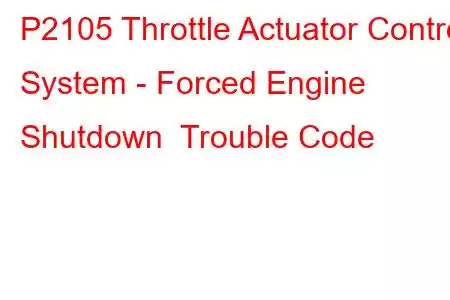P2105 Throttle Actuator Control System - Forced Engine Shutdown
OBD-II Trouble Code Technical Description
Throttle Actuator Control System - Forced Engine Shutdown
What does that mean?
This generic powertrain diagnostic trouble code (DTC) typically applies to all OBD-II equipped vehicles that use a drive-by-wire throttle control system including but not limited to vehicles from Ford, GMC, Hyundai, Land Rover, Toyota, Dodge, Chevy, Subaru, Suzuki, Jaguar etc. Anecdotally this code seems to be more commonly seen on Ford, Chevrolet, and Land Rover vehicles.
The P2105 OBD-II trouble code is one of number of possible codes that indicates that the Powertrain Control Module (PCM) has detected a malfunction and is limiting the operation of the Throttle Actuator Control System
This situation is known as activating a fail-safe or limp mode to prevent the engine from accelerating until this malfunction is corrected and the associated code is cleared. There are four codes that are referred to as force codes and they are P2104, P2105, P2106 and P2110.
The PCM sets these when other codes are present that indicate an issue that may be safety related or cause damage to the engine or drivetrain components if not corrected in a timely manner.
Code P2105 is set by the PCM to force the Throttle Actuator Control System to shut the engine down.
This code can be related to a Throttle Actuator Control System malfunction, but normally another issue is setting this code. Trouble code P2105 is triggered by the PCM when it receives an abnormal signal from various components. The Throttle Actuator Control System is duty cycle controlled by the PCM and the function of the system is limited when other fault codes are detected.
Code Severity & Symptoms
The severity of this code can be moderate to severe based on the specific malfunction. Symptoms of a P2105 trouble code may include:
Engine will not start Little or no throttle response Check Engine Light illuminated ABS Light illuminated Automatic transmission will not shift Additional codes are presentCommon Causes Of This DTC Code
The most common situations that set this code and place the engine in fail-safe or limp mode to indicate an issue and act as a red flag are:
Engine Overheating Coolant Leaks EGR Valve Malfunction Mass Air Flow Sensor Malfunction Drive Axle Modifications ABS, Traction Control or Stability Control Failures Automatic Transmission Problems Abnormal System VoltagesWhat are some common repairs?
Repair coolant leak Replacing or cleaning ABS sensor Replacing or cleaning EGR Valve Replacing or cleaning Mass Airflow sensor Cleaning corrosion from connectors Repairing or replacing wiring Flashing or replacing PCMDiagnostic and Repair Procedures
The first step in the troubleshooting process for any malfunction is to research the Technical Service Bulletins (TSB's) for the specific vehicle by year, model and power plant. In some circumstances this can save a lot of time in the long run by pointing you in the right direction.
The second step for this code is to complete a PCM scan to identify other trouble codes. This code is an informational code and in most circumstances this code’s function is to alert a driver that the PCM has initiated a fail-safe mode because of a malfunction or failure in a system that is not directly related to the Throttle Control Actuator.
If other codes are identified you should check for TSB's related to the specific vehicle and that code. If a TSB has not been generated you should follow the specific troubleshooting steps for that code to pinpoint the source of the malfunction that the PCM is detecting to put the engine in fail-safe or limp mode.
Once all other codes have been cleared or if no other codes are detected, if the Throttle Control Actuator code still exists the PCM and
Read: 24


